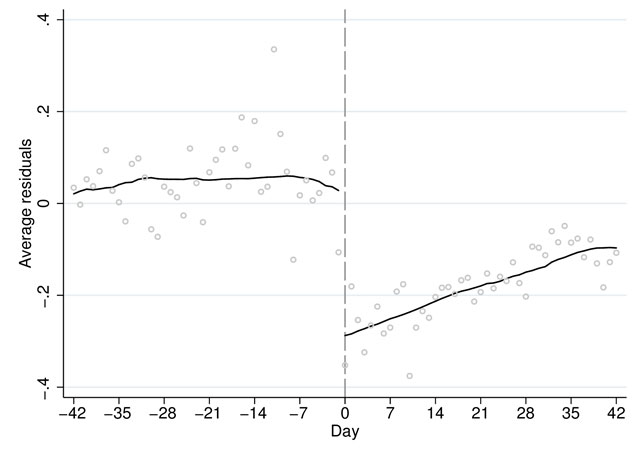The lockdown imposed to fight the Covid-19 pandemic has had wide-ranging consequences for the society. This article analyses the impact of the lockdown on criminal activity in Bihar using up-to-date police information reports. The results show that the lockdown decreased aggregate crime by 44%. Large negative effects are observed for diverse types of crimes such as murder (61%), theft (63%), and crimes against women (64%), among others.
The Covid-19 pandemic has brought the world to a standstill, threatening nations' economies, and causing unprecedented human and socioeconomic losses. Strict lockdowns have been imposed by governments around the world to contain the spread of the virus. In late March, India decided to impose the biggest lockdown in the world with nearly 1.3 billion people confined at home. Unfortunately, until the threat of Covid-19 has been fully contained, lockdowns are likely to remain in place across the world.
To enforce the lockdown, governments have diverted police resources from crime prevention towards controlling the compliance with stay-at-home orders and imposing penalties. This could be particularly problematic when the number of police officers to population is low (as it is the case in India), as this provides an opportunity for offenders to expand their criminal activity. However, mobility restrictions imposed by lockdowns could also make it harder for criminals to find victims. The net effects on crime are not obvious, and whether certain types of crimes are more affected by the lockdown, is unknown.
In recent research (Poblete-Cazenave 2020), I study the impact of the lockdown on criminal activity in the state of Bihar. Bihar is particularly interesting since it has the lowest number of policemen per 100,000 population in the country.1 Hence, enforcing the lockdown has added extra pressure on an already overburdened police force. Also, the sudden lockdown with immediate effect ordered by the state government of Bihar on Sunday, 22 March resulted in unexpected restrictions on the movement of individuals and the closure of all establishments, except those providing essential goods and services.
To study the effect of the lockdown on crime, I use up-to-date criminal case-level information obtained from police stations' First Information Reports (FIR)2, and harness the sudden introduction of the state-wide lockdown. Using a 'regression discontinuity approach', I compare criminal activity around the dates when the lockdown was imposed to find a causal impact of the lockdown on crime. In this sense, if all other factors affecting crime, apart from the lockdown, do not change discontinuously at the transition date, this strategy provides a consistent estimate of the impact of lockdown on crime.
Do lockdowns affect criminal activity?
From the beginning of 2020 until 27 May, more than 80,000 criminal cases were filed in Bihar. Before the lockdown, a police station received, on average, 0.7 criminal cases per day, while after the imposition of the lockdown this number decreased to 0.5. To get a causal estimate of the impact of lockdowns on crime, I first account for the temporal persistence of crimes and use the approach described above. Figure 1 shows the impact of the lockdown on the number of crimes (demeaned by the day-of-month)3. There is a discontinuous decrease in criminal activity at the day the lockdown was imposed (Day 0), which is followed by an upward trend as the lockdown progresses. In particular, the estimation shows that the lockdown decreases aggregate crime by 44%. This large reduction suggests that the difficulties faced by criminals in finding victims have a higher impact on crime than the reduction of police officers involved in crime prevention.
Figure 1. Impact of lockdown on the number of crimes: Daily estimates of local linear regression

Notes: In solid lines are the predicted values for the total number of crimes (demeaned by day-of-the-month) based on the following local linear regression.'Day' is the number of days since the start of the lockdown denoted as Day 0. The scatter plot is the daily average of the total number of crimes, demeaned by day-of-the-month.
Does the effect vary across types of crimes?
When analysing the impact of lockdowns on crime, it is important to consider the nature of the crimes and the settings where they take place. This would provide additional insights into the reasons why we observe this large decrease in crime. Certain crimes are more susceptible than others to: (i) the difficulty in finding victims, and/or (ii) to the diversion of police officers to enforce lockdowns. For instance, property crimes, such as theft, which are economically motivated and usually occur in the streets, might be impacted by both channels, while crimes of passion like murders might only be affected by the offenders' inability to find the victim at the same place and time.
Also, stay-at-home orders could have contrasting effects on different crimes. For instance, crimes related to domestic violence might increase due to the lockdowns, since the crime is committed indoors, and perpetrators and victims are confined within the same space for longer periods of time. To study differential effects across crimes categories, I use the Indian Penal Codes (IPC) to identify the following types of crimes: murder, theft, robbery, burglary, kidnapping, rioting, crimes against women, and crimes against public health workers.4
Figure 2 shows the immediate effect of the lockdown on each type of crime. Despite their diverse nature, there are large effects for all the crime categories. There is a decrease of 63% in the number of thefts, 49% in burglaries, 56% in robberies, 61% in murders, 88% in kidnappings, 77% in rioting, and 64% in crimes against women. Given the types of crimes, these results provide further support that the main reason for the crime reduction is the lack of potential victims on the streets. Although, as shown by the 143% increase in crimes against public health workers during the lockdown, significant numbers of people are still transiting the streets. Note that the results show the impact of lockdown on dates around the imposition of the lockdown.
Figure 2. Estimates of the impact of the lockdown on crime, by category of crime

Notes: Regression discontinuity estimates for different types of crimes are shown. The dependent variable is the number of crimes demeaned by day-of-month. The sample contains dates within 21 days of the beginning of the lockdown. Observations are taken daily at the police-station level.
Do the severity and the duration of lockdown restrictions matter?
To ease the socioeconomic consequences of the lockdown, the central government relaxed the restrictions by classifying districts across India based on the number of Covid-19 cases and propagation of the virus. This transition towards restriction zones occurred almost a month after the start of the lockdown. I use the restriction zones to examine whether the severity of the lockdown affects criminal activity differently.
In line with the main results, the evidence shows that relaxing lockdown’s initial restrictions increased crime. However, the increment in crime is lower in less restrictive lockdowns than in restrictive ones, revealing that another channel might be in place. Interestingly, violent crimes were not significantly impacted by the transition to the restriction zones, whereas economically motivated crimes were. This suggests that the economic downturn produced by prolonged lockdowns might be driving this result. Strict and prolonged lockdown measures severely impact economic activity, increase unemployment, and affect individuals' financial outcomes, which are relevant factors affecting crime (Mocan and Bali 2010, Bell et al. 2018), and violence against women (Anderberg et al. 2016, Bhalotra et al. 2020). Indeed, after almost a month into the lockdown, more restrictive lockdowns have shown to intensify violence against women. This is also confirmed through analyses of complaints received by the National Commission of Women, where reported cases increased by a staggering 140% in the most restrictive zones.
Lessons for future lockdowns
An important implication of this study is that the large reduction in crime produced by the lockdown could allow authorities to free up police resources for pandemic containment. Also, with regard to criminal activity, it is recommended that less restrictive lockdowns be implemented that allow for functioning of businesses and shops in a controlled manner. This could prevent economic factors from negatively affecting crime. Additionally, resources must be reallocated to cope with crimes that could increase as a by-product of the lockdown, such as in the case for violence against women (domestic violence) in high restriction zones.
Notes:
- According to Data on Police Organization 2019 Report, the number of police officer per 100,000 people in Bihar is 81, whereas for India this is 158.
- The First Information Report is a written document prepared by the police when receiving the complaint of an alleged commission of an offence, after which the police can start an investigation.
- To make crimes across days comparable, we use deviation from the mean (average) to remove persistent differences across days of the month. If the number of reported cases by the end of the month is consistently higher than those reported at the beginning of the next month, not accounting for this biases the effect of the lockdown on crimes.
- The most common charge for crimes against women is 'assault or criminal force to woman with intent to outrage her modesty' (IPC 354). This comprises more than 70% of this type of crime.
Further Reading
- Anderberg, Dan, Helmut Rainer, Jonathan Wadsworth and Tanya Wilson (2016), “Unemployment and domestic violence: Theory and evidence”, The Economic Journal, 126(597):1947-1979.
- Bell, Brian, Anna Bindler and Stephen Machin (2018), “Crime scars: Recessions and the making of career criminals”, The Review of Economics and Statistics, 100(3):392-404.
- Bhalotra, S, U Kambhampati, S Rawlings and Z Siddique (2020), ‘Intimate partner violence: The influence of job opportunities for men and women’, Policy Research Working Paper No. WPS 9118, World Bank Group, Washington, D.C.
- Mocan, H Naci and Turan G Bali (2010), “Asymmetric crime cycles”, The Review of Economics and Statistics, 92(4):899-911.
- Poblete-Cazenave, R (2020), ‘The Great Lockdown and Criminal Activity - Evidence from Bihar, India’, 8 June 2020.




 23 June, 2020
23 June, 2020 




Comments will be held for moderation. Your contact information will not be made public.